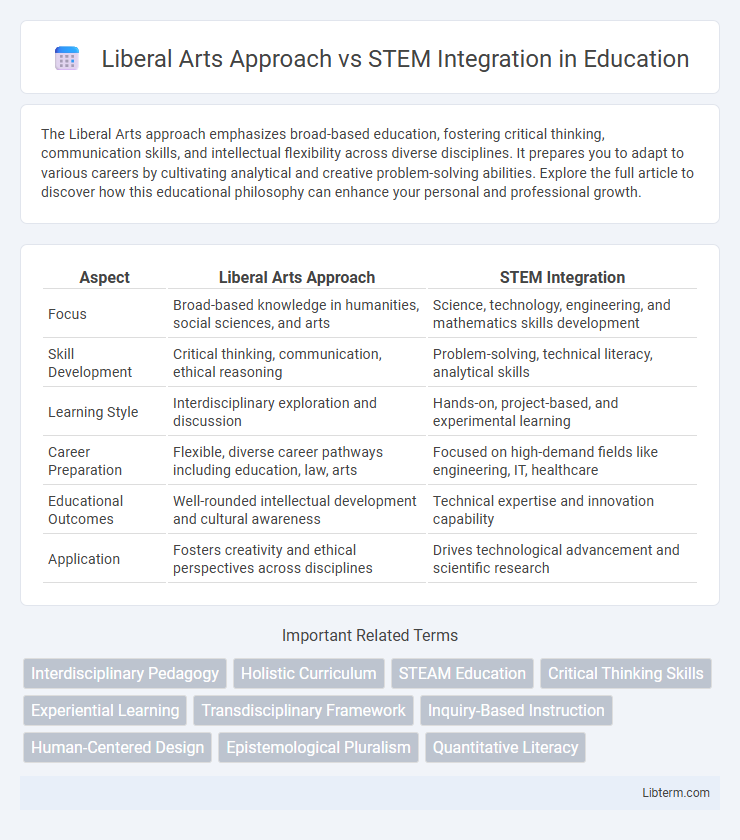The Liberal Arts approach emphasizes broad-based education, fostering critical thinking, communication skills, and intellectual flexibility across diverse disciplines. It prepares you to adapt to various careers by cultivating analytical and creative problem-solving abilities. Explore the full article to discover how this educational philosophy can enhance your personal and professional growth.
Table of Comparison
| Aspect | Liberal Arts Approach | STEM Integration |
|---|---|---|
| Focus | Broad-based knowledge in humanities, social sciences, and arts | Science, technology, engineering, and mathematics skills development |
| Skill Development | Critical thinking, communication, ethical reasoning | Problem-solving, technical literacy, analytical skills |
| Learning Style | Interdisciplinary exploration and discussion | Hands-on, project-based, and experimental learning |
| Career Preparation | Flexible, diverse career pathways including education, law, arts | Focused on high-demand fields like engineering, IT, healthcare |
| Educational Outcomes | Well-rounded intellectual development and cultural awareness | Technical expertise and innovation capability |
| Application | Fosters creativity and ethical perspectives across disciplines | Drives technological advancement and scientific research |
Understanding the Liberal Arts Approach
The Liberal Arts Approach emphasizes critical thinking, interdisciplinary learning, and the development of communication skills through exposure to humanities, social sciences, and natural sciences. This educational model fosters intellectual curiosity and cultural awareness, preparing students for diverse career paths and lifelong learning. It contrasts with STEM integration by prioritizing broad cognitive skills and ethical reasoning over technical specialization.
Defining STEM Integration
STEM integration involves blending science, technology, engineering, and mathematics into a unified curriculum that encourages interdisciplinary learning and real-world problem-solving. This approach emphasizes hands-on projects and collaborative experiences, contrasting with the traditional liberal arts method that focuses more broadly on humanities, arts, and critical thinking. Defining STEM integration requires understanding its goal to enhance student engagement and proficiency by connecting concepts across STEM fields in practical, applied contexts.
Historical Contexts of Both Paradigms
The liberal arts approach traces its roots to classical antiquity and the Renaissance, emphasizing broad critical thinking and ethical reasoning across disciplines such as literature, philosophy, and history. STEM integration emerged prominently during the 20th century, driven by technological advancements and the demand for expertise in science, technology, engineering, and mathematics to fuel industrial and scientific innovation. Historically, liberal arts education aimed to cultivate well-rounded individuals, while STEM focused on specialized skills to address practical challenges and economic growth.
Core Philosophies: Breadth vs. Depth
The liberal arts approach emphasizes breadth, fostering critical thinking and interdisciplinary knowledge across humanities, social sciences, and natural sciences to develop well-rounded intellectual skills. STEM integration prioritizes depth, concentrating on mastery of specific scientific, technological, engineering, and mathematical disciplines to cultivate specialized expertise and technical problem-solving abilities. Balancing these core philosophies challenges educational institutions to combine broad-based inquiry with focused skill development, enhancing both adaptable thinking and domain-specific competence.
Skills Acquired: Critical Thinking vs. Technical Proficiency
The liberal arts approach cultivates critical thinking, problem-solving, and communication skills essential for analyzing complex issues and fostering creativity. STEM integration emphasizes technical proficiency, including quantitative analysis, coding, and scientific methodology crucial for innovation and practical application in technology-driven fields. Combining both approaches produces well-rounded individuals equipped with analytical reasoning and specialized technical expertise.
Interdisciplinary Learning Opportunities
Liberal arts approach emphasizes broad-based knowledge across humanities, social sciences, and natural sciences, fostering critical thinking, creativity, and communication skills. STEM integration focuses on combining science, technology, engineering, and mathematics to enhance problem-solving abilities and technical expertise. Interdisciplinary learning opportunities arise when both approaches merge, promoting collaboration across diverse fields and preparing students for complex, real-world challenges.
Impact on Career Prospects
Liberal arts education fosters critical thinking, communication, and adaptability skills highly valued in diverse career fields, enhancing long-term career flexibility and leadership potential. STEM integration emphasizes technical expertise, problem-solving abilities, and innovation, which are directly applicable to fast-growing industries such as technology, engineering, and healthcare, often leading to higher initial job placement rates and salaries. Combining liberal arts and STEM education creates a well-rounded skill set, improving employability by blending creativity with technical proficiency to meet evolving market demands.
Pedagogical Methods Compared
The Liberal Arts approach emphasizes critical thinking, interdisciplinary connections, and Socratic dialogue to foster broad analytical skills, while STEM integration utilizes inquiry-based learning, hands-on experimentation, and technology-driven simulations to enhance problem-solving and technical proficiency. Pedagogical methods in Liberal Arts often center on discussion, reflective writing, and ethical reasoning, contrasting with STEM's focus on project-based learning, data analysis, and iterative design processes. Both approaches prioritize active engagement but differ in cognitive skill development, with Liberal Arts nurturing conceptual understanding and STEM advancing applied competencies.
Addressing Modern Workforce Needs
The Liberal Arts approach fosters critical thinking, creativity, and communication skills essential for adapting to diverse workplace challenges, while STEM integration emphasizes technical expertise and problem-solving capabilities required in technology-driven industries. Combining both approaches equips the modern workforce with interdisciplinary knowledge, enhancing innovation and effective collaboration across sectors. Employers increasingly seek candidates proficient in STEM fields who also demonstrate the contextual reasoning and ethical understanding cultivated through liberal arts education.
Bridging the Gap: Hybrid Educational Models
Hybrid educational models combine the critical thinking and creativity of the liberal arts approach with the technical skills and innovation-driven focus of STEM integration. These models foster interdisciplinary learning environments that prepare students for complex problem-solving and adaptable career paths by blending humanities, social sciences, mathematics, and technology. Research shows that hybrid curricula enhance cognitive flexibility, collaboration, and real-world application, bridging the gap between abstract reasoning and technical expertise.
Liberal Arts Approach Infographic

 libterm.com
libterm.com